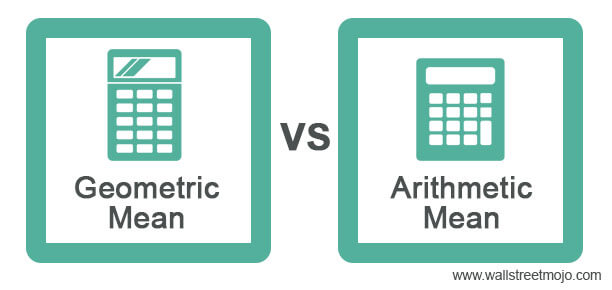Table Of Contents
Differences Between Geometric and Arithmetic Mean
The geometric mean is the calculation of the mean or average of a series of product values which takes into account the effect of compounding. It is used for determining investment performance, whereas arithmetic means the calculation of the mean by the sum of total values divided by the number of values.

The geometric mean is calculated for a series of numbers by taking the product of these numbers and raising it to the inverse series length of the series. The arithmetic mean is the average calculated by adding all the numbers and dividing by the count of that series of numbers.
Geometric Mean vs. Arithmetic Mean Infographics

Key Differences
- The arithmetic mean is known as the additive mean and is used in the everyday calculation of returns. The geometric mean is known as the multiplicative mean and is a little complicated and involves compounding.
- The main difference in both these means is the way to calculate. The arithmetic mean is calculated as the sum of all the numbers divided by the number of the dataset. The geometric mean is a series of numbers calculated by taking the product of these numbers and raising it to the inverse of the length of the series.
- Formula for geometric mean is {^(1/n)]} – 1, and for the arithmetic mean is (Return1 + Return2 + Return3 + Return4)/ 4.
- The Geometric mean can only be calculated for positive numbers and is always less than the geometric ones. Meanwhile, the arithmetic mean can be calculated for positive and negative numbers and is always greater than the geometric mean.
- A common problem with having a dataset is the effect of outliers. In a dataset of 11, 13, 17, and 1000 the geometric mean is 39.5, while the arithmetic means is 260.75. The effect highlights. The geometric mean normalizes the dataset, and the values are averaged out. Hence, no range dominates the weights, and any percentage does not significantly affect the data set. The geometric mean is not influenced by skewed distributions as the arithmetic Portfolio Manager average is.
- The arithmetic mean is used by statisticians but for data sets with no significant outliers. This type of mean is useful for reading temperatures. It is also helpful in determining the average speed of the car. On the other hand, the geometric mean is useful in cases where the dataset is logarithmic or varies by multiples of 10.
- Many biologists use this type of means to describe the size of the bacterial population. For example, the bacterial population can be 10 in one day and 10,000 in others. One can also calculate income distribution using a geometric average. For example, X and Y make $30,000 yearly, while Z makes $300,000 annually. In this case, the arithmetic average will not be useful. Portfolio managers highlight how an individual's wealth has increased or decreased.
Comparative Table
| Basis | Geometric Mean | Arithmetic Mean |
|---|---|---|
| 1. Formula | Geometric mean is the multiplicative mean. {^(1/n)]} – 1 | Arithmetic mean is known as additive mean. (Return1 + Return2 + Return3 + Return4)/ 4 |
| 2. Values | Due to the compounding effect, the geometric mean is always lower than the arithmetic means. | The arithmetic mean is always higher than the geometric mean as it is calculated as a simple average. |
| 3. Calculation | Suppose a dataset has the following numbers – 50, 75, 100. The geometric mean is calculated as the cube root of (50 x 75 x 100) = 72.1. | Similarly, for a dataset of 50, 75, and 100, the arithmetic mean is calculated as (50+75+100)/3 = 75 |
| 4. Dataset | It applies only to only a positive set of numbers. | It can be calculated with both positive and negative sets of numbers. |
| 5. Usefulness | Geometric mean can be more useful when the dataset is logarithmic. The difference between the two values is the length. | This method is more appropriate when calculating the mean value of the outputs of a set of independent events. |
| 6. Effect of Outlier | The effect of outliers on the Geometric mean is mild. Consider the dataset 11,13,17 and 1000. In this case, 1000 is the outlier. Here, the average is 39.5. | The arithmetic mean has a severe effect on outliers. In the dataset 11,13,17 and 1000, the average is 260.25. |
| 7. Uses | The geometric mean is used by biologists, economists, and financial analysts. Therefore, it is most appropriate for a dataset that exhibits correlation. | The arithmetic mean is used to represent average temperature and car speed. |
Conclusion
The geometric mean is appropriate for percentage changes, volatile numbers, and correlation data, especially investment portfolios. Most financial returns correlate with stocks, bond yield, and premiums. The longer period makes the compounding effect more critical and hence the use of a geometric mean. While for independent data sets, arithmetic means is more appropriate as it is simple to use and easy to understand.
